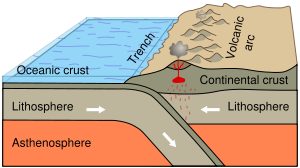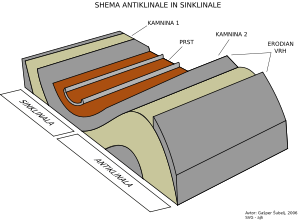Geology
2008/9 Schools Wikipedia Selection. Related subjects: Geology and geophysics
Geology (from Greek: γη, gê, "earth"; and λόγος, logos, "speech" lit. to talk about the earth) is the science and study of the solid matter that constitutes the Earth. Encompassing such things as rocks, soil, and gemstones, geology studies the composition, structure, physical properties, history, and the processes that shape Earth's components. It is one of the Earth sciences. Geologists have established the age of the Earth at about 4.6 billion (4.6x109) years, and have determined that the Earth's lithosphere, which includes the crust, is fragmented into tectonic plates that move over a rheic upper mantle ( asthenosphere) via processes that are collectively referred to as plate tectonics. Geologists help locate and manage the Earth's natural resources, such as petroleum and coal, as well as metals such as iron, copper, and uranium. Additional economic interests include gemstones and many minerals such as asbestos, perlite, mica, phosphates, zeolites, clay, pumice, quartz, and silica, as well as elements such as sulfur, chlorine, and helium. Geology is also of great importance in the applied fields of civil engineering, soil mechanics, hydrology, environmental engineering and geohazards.
Planetary geology (sometimes known as Astrogeology) refers to the application of geologic principles to other bodies of the solar system. Specialised terms such as selenology (studies of the moon), areology (of Mars), etc., are also in use. Colloquially, geology is most often used with another noun when indicating extra-Earth bodies (e.g. "the geology of Mars").
The word "geology" was first used by Jean-André Deluc in the year 1778 and introduced as a fixed term by Horace-Bénédict de Saussure in the year 1779. The science was not included in Encyclopædia Britannica's third edition completed in 1797, but had a lengthy entry in the fourth edition completed by 1809. An older meaning of the word was first used by Richard de Bury to distinguish between earthly and theological jurisprudence.
History

The work Peri Lithon (On Stones) by Theophrastus (372-287 BC), a student of Aristotle, remained authoritative for millennia. Its interpretation of fossils was not overturned until after the Scientific Revolution. Peri Lithon was translated into Latin and some other foreign languages. Much later in the Roman period, Pliny the Elder produced a very extensive discussion of many more minerals and metals then widely used for practical ends. He is among the first to correctly identify the origin of amber as a fossilized resin from pine trees by the observation of insects trapped within some pieces. He also laid the basis of crystallography by recognising the octahedral habit of diamond.
Some modern scholars, such as Fielding H. Garrison, are of the opinion that modern geology began in the Muslim world. Abu al-Rayhan al-Biruni (973-1048 AD) was one of the earliest Muslim geologists, whose works included the earliest writings on the geology of India. Ibn Sina (Avicenna, 981 - 1037 C.E.), in particular, made significant contribution to natural sciences (which he called Attabieyat) along with other natural philosophers such as Ikhwan AI-Safa and many others. He wrote an encyclopaedic work entitled “Kitab AI-Shifa” (the Book of Cure, Healing or Remedy from ignorance), in which Part 2, Section 5, contains his essay on Mineralogy and Meteorology, in six chapters: Formation of mountains, The advantages of mountains in the formation of clouds; Sources of water; Origin of earthquakes; Formation of minerals; The diversity of earth’s terrain. These principles were later known in the Renaissance of Europe as the law of superposition of strata, the concept of catastrophisim, and the doctrine of uniformitarianism. These concepts were also embodied in the Theory of the Earth by James Hutton in the Eighteenth century C.E. Academics such as Toulmin and Goodfield (1965), commented on Avicenna's contribution: "Around A.D. 1000, Avicenna was already suggesting a hypothesis about the origin of mountain ranges, which in the Christian world, would still have been considered quite radical eight hundred years later".
In China, the polymath Shen Kua (1031-1095) formulated a hypothesis for the process of land formation: based on his observation of fossil shells in a geological stratum in a mountain hundreds of miles from the ocean, he inferred that the land was formed by erosion of the mountains and by deposition of silt.
Georg Agricola (1494-1555), a physician, wrote the first systematic treatise about mining and smelting works, De re metallica libri XII, with an appendix Buch von den Lebewesen unter Tage (Book of the Creatures Beneath the Earth). He covered subjects like wind energy, hydrodynamic power, melting cookers, transport of ores, extraction of soda, sulfur and alum, and administrative issues. The book was published in 1556. Nicolas Steno (1638-1686) is credited with the law of superposition, the principle of original horizontality, and the principle of lateral continuity: three defining principles of stratigraphy. Previous attempts at such statements meet accusations of heresy from the Church.
By the 1700s Jean-Étienne Guettard and Nicolas Desmarest hiked central France and recorded their observations on geological maps; Guettard recorded the first observation of the volcanic origins of this part of France.
William Smith (1769-1839) drew some of the first geological maps and began the process of ordering rock strata (layers) by examining the fossils contained in them.
James Hutton is often viewed as the first modern geologist. In 1785 he presented a paper entitled Theory of the Earth to the Royal Society of Edinburgh. In his paper, he explained his theory that the Earth must be much older than had previously been supposed in order to allow enough time for mountains to be eroded and for sediments to form new rocks at the bottom of the sea, which in turn were raised up to become dry land. Hutton published a two-volume version of his ideas in 1795 ( Vol. 1, Vol. 2).
Followers of Hutton were known as Plutonists because they believed that some rocks were formed by vulcanism which is the deposition of lava from volcanoes, as opposed to the Neptunists, who believed that all rocks had settled out of a large ocean whose level gradually dropped over time.
In 1811 Georges Cuvier and Alexandre Brongniart published their explanation of the antiquity of the Earth, inspired by Cuvier's discovery of fossil elephant bones in Paris. To prove this, they formulated the principle of stratigraphic succession of the layers of the earth. They were independently anticipated by William Smith's stratigraphic studies on England and Scotland.
By 1827 Charles Lyell's Principles of Geology reiterated Hutton's uniformitarianism, which influenced the thought of Charles Darwin.
Sir Charles Lyell first published his famous book, Principles of Geology, in 1830 and continued to publish new revisions until he died in 1875. He successfully promoted the doctrine of uniformitarianism. This theory states that slow geological processes have occurred throughout the Earth's history and are still occurring today. In contrast, catastrophism is the theory that Earth's features formed in single, catastrophic events and remained unchanged thereafter. Though Hutton believed in uniformitarianism, the idea was not widely accepted at the time.
19th century geology revolved around the question of the Earth's exact age. Estimates varied from a few 100,000 to billions of years. The most significant advance in 20th century geology has been the development of the theory of plate tectonics in the 1960s. Plate tectonic theory arose out of two separate geological observations: seafloor spreading and continental drift. The theory revolutionized the Earth sciences.
The theory of continental drift was proposed by Frank Bursley Taylor in 1908, expanded by Alfred Wegener in 1912 and by Arthur Holmes, but wasn't broadly accepted until the late 1960s when the theory of plate tectonics was developed.
Important principles of geology
There are a number of important principles in geology. Many of these involve the ability to provide the relative ages of strata or the manner in which they were formed.
The principle of intrusive relationships concerns crosscutting intrusions. In geology, when an igneous intrusion cuts across a formation of sedimentary rock, it can be determined that the igneous intrusion is younger than the sedimentary rock. There are a number of different types of intrusions, including stocks, laccoliths, batholiths, sills and dikes.
The principle of cross-cutting relationships pertains to the formation of faults and the age of the sequences through which they cut. Faults are younger than the rocks they cut; accordingly, if a fault is found that penetrates some formations but not those on top of it, then the formations that were cut are older than the fault, and the ones that are not cut must be younger than the fault. Finding the key bed in these situations may help determine whether the fault is a normal fault or a thrust fault.
The principle of inclusions and components states that, with sedimentary rocks, if inclusions (or clasts) are found in a formation, then the inclusions must be older than the formation that contains them. For example, in sedimentary rocks, it is common for gravel from an older formation to be ripped up and included in a newer layer. A similar situation with igneous rocks occurs when xenoliths are found. These foreign bodies are picked up as magma or lava flows, and are incorporated, later to cool in the matrix. As a result, xenoliths are older than the rock which contains them.
The principle of uniformitarianism states that the geologic processes observed in operation that modify the Earth's crust at present have worked in much the same way over geologic time. A fundamental principle of geology advanced by the 18th century Scottish physician and geologist James Hutton, is that "the present is the key to the past." In Hutton's words: "the past history of our globe must be explained by what can be seen to be happening now."
The principle of original horizontality states that the deposition of sediments occurs as essentially horizontal beds. Observation of modern marine and non-marine sediments in a wide variety of environments supports this generalization (although cross-bedding is inclined, the overall orientation of cross-bedded units is horizontal).
The principle of superposition states that a sedimentary rock layer in a tectonically undisturbed sequence is younger than the one beneath it and older than the one above it. Logically a younger layer cannot slip beneath a layer previously deposited. This principle allows sedimentary layers to be viewed as a form of vertical time line, a partial or complete record of the time elapsed from deposition of the lowest layer to deposition of the highest bed.
The principle of faunal succession is based on the appearance of fossils in sedimentary rocks. As organisms exist at the same time period throughout the world, their presence or (sometimes) absence may be used to provide a relative age of the formations in which they are found. Based on principles laid out by William Smith almost a hundred years before the publication of Charles Darwin's theory of evolution, the principles of succession were developed independently of evolutionary thought. The principle becomes quite complex, however, given the uncertainties of fossilization, the localization of fossil types due to lateral changes in habitat ( facies change in sedimentary strata), and that not all fossils may be found globally at the same time.
Fields or related disciplines

Oceanic-continental convergence resulting in subduction and volcanic arcs illustrates one effect of plate tectonics.
|
|
|



